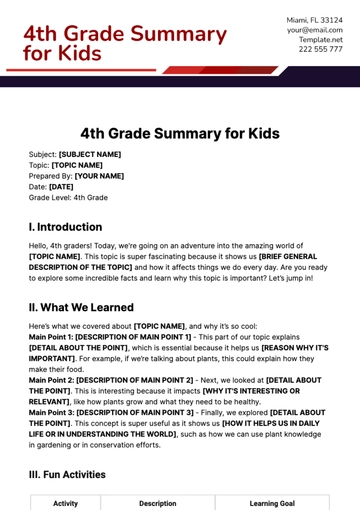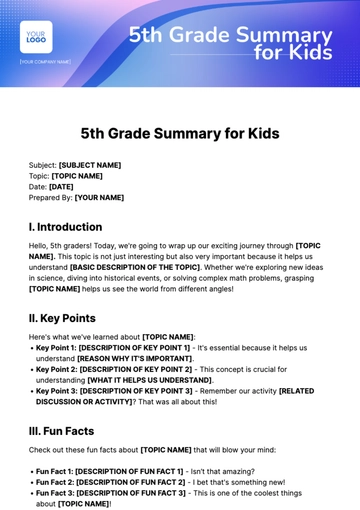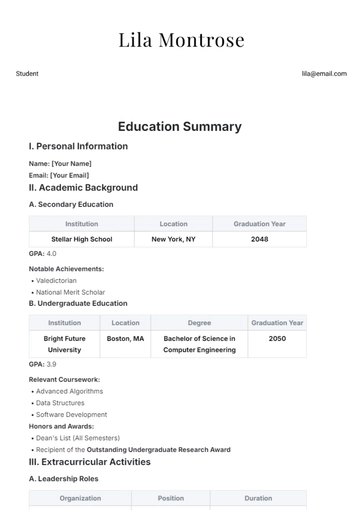Free Leadership Article Review Summary

Prepared by: [YOUR NAME]
Introduction:
The [LEADERSHIP ARTICLE TITLE] by [AUTHOR'S] offers valuable insights into contemporary leadership theories and practices. The introduction provides an overview of the importance of effective leadership in organizational success, highlighting the role of leaders in inspiring and motivating teams towards achieving common goals. The [AUTHOR'S] outline the objectives of the article, which may include exploring various leadership styles, traits, and their impact on organizational performance. Through a comprehensive analysis of leadership principles, the article aims to equip readers with the knowledge and skills necessary to excel in leadership roles.
Leadership Theories and Models:
A. Transformational Leadership
The article delves into [TRANSFORMATIONAL LEADERSHIP], emphasizing the importance of visionary leaders who inspire and empower their teams to achieve exceptional results. It explores key characteristics of transformational leaders, such as charisma, vision, and the ability to foster a shared sense of purpose. The [AUTHOR'S] provide examples of transformational leaders and their impact on organizational culture and performance, highlighting best practices for implementing transformational leadership in diverse organizational contexts.
B. Situational Leadership
Drawing on [SITUATIONAL LEADERSHIP] theory, the article explores how effective leaders adapt their leadership style to suit the needs of different situations and team members. It examines the four leadership styles proposed by Hersey and Blanchard, namely directing, coaching, supporting, and delegating, and discusses the importance of assessing follower readiness levels to determine the most appropriate leadership approach. The [AUTHOR'S] offer practical strategies for applying situational leadership theory in real-world scenarios, emphasizing the importance of flexibility and responsiveness in leadership.
Key Takeaways:
Importance of Transformational Leadership: The article underscores the significance of [TRANSFORMATIONAL LEADERSHIP] in driving organizational success through visionary leadership practices, emphasizing the role of leaders in inspiring and empowering their teams.
Key Characteristics of Transformational Leaders: It explores essential traits such as [CHARISMA], [VISION], and [EMPATHY], highlighting how these attributes contribute to fostering a sense of purpose and motivation among team members.
Leadership Style | Advantages | Limitations |
|---|---|---|
[TRANSFORMATIONAL LEADERSHIP] | Boosts morale, encourages innovation | Requires immense time and effort |
[SERVANT LEADERSHIP] | Enhances team-building, trust-building | Can lead to undervaluation of leader |
[AUTOCRATIC LEADERSHIP] | Decisive, efficient | May suppress creativity |
[DEMOCRATIC LEADERSHIP] | Fosters ownership, encourages honesty | Can be time-consuming |
Leadership Challenges and Solutions:
A. Leading Through Change
The article addresses the challenges of leading through [ORGANIZATIONAL CHANGE] in today's dynamic business environment. It explores common obstacles encountered by leaders during periods of organizational change, such as resistance to change, communication breakdowns, and employee morale issues. The [AUTHOR'S] offer strategies for effectively navigating change, including transparent communication, stakeholder engagement, and fostering a culture of resilience and adaptability.
B. Building High-Performing Teams
Analyzing the importance of team dynamics in organizational success, the article discusses strategies for building and leading [HIGH-PERFORMING TEAMS]. It explores factors contributing to team effectiveness, such as clear goals, effective communication, trust, and accountability. The [AUTHOR'S] offer practical tips for fostering a positive team culture, resolving conflicts, and maximizing team potential to achieve shared objectives.
CONCLUSION:
In conclusion, the exploration of various leadership styles underscores the complexity and diversity within the realm of leadership. Each style offers unique [ADVANTAGES] and [LIMITATIONS], catering to different organizational contexts and preferences. Leaders must carefully consider the needs of their teams and the goals of their organizations when selecting a leadership approach. While [TRANSFORMATIONAL LEADERSHIP] can inspire innovation and boost morale, it requires substantial time and effort. [SERVANT LEADERSHIP] fosters trust and teamwork but may risk the undervaluation of the leader's role. [AUTOCRATIC LEADERSHIP] ensures efficiency but may stifle creativity, while [DEMOCRATIC LEADERSHIP] promotes ownership but can be time-consuming. Ultimately, effective leadership entails a balance between leveraging the strengths of different styles and adapting them to meet the dynamic challenges of today's organizations.
- 100% Customizable, free editor
- Access 1 Million+ Templates, photo’s & graphics
- Download or share as a template
- Click and replace photos, graphics, text, backgrounds
- Resize, crop, AI write & more
- Access advanced editor
Unlock leadership insights effortlessly with Template.net's Leadership Article Review Summary. This editable and customizable template streamlines the process of summarizing and analyzing leadership articles. Easily tailor summaries in our Ai Editor Tool, ensuring concise, impactful reviews that empower growth and development in leadership skills.





























